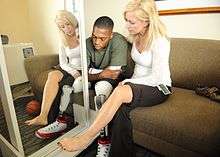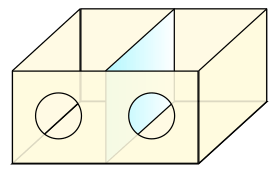Mirror therapy
Mirror therapy (MT) or mirror visual feedback is a therapy for pain or disability that affects one side of the patient more than the other side. It was invented by Vilayanur S. Ramachandran to treat post-amputation patients who suffered from phantom-limb pain (PLP). Ramachandran created a visual (and psychological) illusion of two intact limbs by putting the patient's intact limb into a "mirror box," with a mirror down the center (facing toward a patient's intact limb).

The patient then looks into the mirror on the side with the good limb and makes "mirror symmetric" movements, as a symphony conductor might, or as a person does when they clap their hands. The goal is for the patient to imagine regaining control over a missing limb. Because the subject is seeing the reflected image of the good limb moving, it appears as if the phantom limb is also moving. Through the use of this artificial visual feedback it becomes possible for the patient to "move" the phantom limb, and to unclench it from potentially painful positions.
Mirror therapy has expanded beyond its origin in treating phantom limb pain to treatment of other kinds of one-sided pain or disability, for instance hemiparesis in post-stroke patients and limb pain in patients with chronic regional pain syndrome.
Post-amputation phantom limb pain


Based on the observation that phantom limb patients were much more likely to report paralyzed and painful phantoms if the actual limb had been paralyzed prior to amputation (for example, due to a brachial plexus avulsion), Ramachandran and Rogers-Ramachandran proposed the "learned paralysis" hypothesis of painful phantom limbs [1] Their hypothesis was that every time the patient attempted to move the paralyzed limb, they received sensory feedback (through vision and proprioception) that the limb did not move. This feedback stamped itself into the brain circuitry through a process of Hebbian learning, so that, even when the limb was no longer present, the brain had learned that the limb (and subsequent phantom) was paralyzed.
Ramachandran created the mirror box to relieve pain by helping an amputee imagine motor control over a missing limb. Mirror therapy is now also widely used for treatment of motor disorders such as hemiplegia or cerebral palsy. As Deconick et al. state in a 2014 review, the mechanism of improved motor control and pain relief may differ from the mechanism of pain relief. Deconick et al., who reviewed only the effects of MVF on sensorimotor control, found that MVF can exert a strong influence on the motor network, mainly through increased cognitive penetration in action control.[2]
Although there has been much research on MVT, authors of many review articles complain about the poor methodology often used, for example, small sample sizes or lack of control groups. For this reason, one 2016 review (based on a review of 8 studies) concluded that the level of evidence was insufficient to recommend MT as a first intention treatment for phantom limb pain.[3]
A 2018 review, (based on 15 studies conducted between 2012 and 2017, out of a pool of 115 publications) also criticized the quality of many reports on mirror therapy (MT), but concluded that "MT seems to be effective in relieving PLP, reducing the intensity and duration of daily pain episodes. It is a valid, simple, and inexpensive treatment for PLP."[4]
A 2018 literature review of phantom limb pain stated that, in randomized controlled trials, mirror therapy reduced pain.[5]
Post-stroke hemiparesis
Treatment with mirror therapy soon expanded beyond its origin in treating phantom limb pain to treatment of other kinds of one-sided pain and loss of motor control, for example in stroke patients suffering from hemiparesis. In 1999 Ramachandran and Eric Altschuler expanded the mirror technique from amputees to improving the muscle control of stroke patients with weakened limbs.[6]
A review article published in 2016 concluded that "Mirror therapy (MT) is a valuable method for enhancing motor recovery in poststroke hemiparesis."[7]
According to a 2017 review of fifteen studies that compared mirror therapy to conventional rehabilitation for the recovery of upper-limb function in stroke survivors, mirror therapy was more successful than CR in promoting recovery.[8]
A 2018 review based on 1685 patients recovering from hemiplegic stroke found mirror therapy provided significant pain relief, while improving motor functions and activities of daily living (ADL).[9]
Thirteen out of seventeen randomized controlled trials found that MT was beneficial for post-stroke patients' legs and feet, according to a 2019 review paper.[10]
Despite considerable research, as of 2016 the underlying neural mechanisms of mirror therapy (MT) for stroke were still unclear.[7][11] As Deconick et al. state in a 2014 review, the mechanism of improved motor control may differ from the mechanism of pain relief.[2]
Complex regional pain syndrome
Mirror therapy is also a recommended therapy for complex regional pain syndrome (CRPS).[12][13]
Virtual reality
Since the 2000s, the visual illusion of regaining control of a damaged limb, which mirror therapy provides, has also been available through virtual reality or robotics.[14]
See also
References
- Ramachandran, V.S., Blakeslee, S.: "Phantoms in the Brain: Probing the Mysteries of the Human Mind", 1998, William Morrow & Company, ISBN 0-688-15247-3
- Deconinck, Frederik JA; Smorenburg, Ana RP (August 26, 2014). "Reflections on Mirror Therapy: A Systematic Review of the Effect of Mirror Visual Feedback on the Brain". Neurorehabilitation and Neural Repair. 29 (4): 349–361. doi:10.1177/1545968314546134. PMID 25160567.
- Jessie, Barbin; Seetha, Vanessa (2016). "The effects of mirror therapy on pain and motor control of phantom limb in amputees: A systematic review". Annals of Physical and Rehabilitation Medicine. 59 (4): 270–275. doi:10.1016/j.rehab.2016.04.001. PMID 27256539.
As to the effect of MT on PLM, the 8 studies concerned reported effectiveness of MT: 4 with a low level of evidence and 4 with a high level of evidence...We cannot recommend MT as a first intention treatment in PLP. The level of evidence is insufficient.
- Campo-Prieto, P; Rodríguez-Fuentes, G (November 14, 2018). "Effectiveness of mirror therapy in phantom limb pain: A literature review". Neurologia. doi:10.1016/j.nrl.2018.08.003. PMID 30447854.
It is a valid, simple, and inexpensive treatment for PLP. The methodological quality of most publications in this field is very limited, highlighting the need for additional, high-quality studies to develop clinical protocols that could maximise the benefits of MT for patients with PLP.
- Kaur, A; Guan, Y (2018). "Phantom limb pain: A literature review". Chin J Traumatol. 21: 366–368. doi:10.1016/j.cjtee.2018.04.006. PMC 6354174. PMID 30583983.
One of the studies showed all 22 patients went through mirror therapy reported a decrease in pain after 4 weeks of treatment. In contrast, only 17% and 33% of the patients in the two controlled groups reported decrease in pain.
- Altschuler, Eric Lewin; Wisdom, Sidney B (12 June 1999). "Rehabilitation of hemiparesis after stroke with a mirror". The Lancet. 353 (9169): 2035–2036. doi:10.1016/S0140-6736(99)00920-4. PMID 10376620. Retrieved 24 July 2019.
Use of the mirror may also help recruit the premotor cortex to help with motor rehabilitation...On a number of neurological and psychological levels, mirror therapy may help to reverse elements of learned disuse of the affected limb.
- Kamal Narayan Arya, Underlying neural mechanisms of mirror therapy: Implications for motor rehabilitation in stroke, Neurology India,2016, Volume64, Issue 1, Pages 38-44
- Pérez-Cruzado, D; Merchán-Baeza, JA; González-Sánchez, M; Cuesta-Vargas, AI (2017). "Systematic review of mirror therapy compared with conventional rehabilitation in upper extremity function in stroke survivors". Aust Occup Ther J. 64: 91–112. doi:10.1111/1440-1630.12342. PMID 28032336.
Fifteen studies were included in the systematic review. Recovery of the upper limb, upper limb function and gross manual dexterity were frequently measured in these studies...In the primary variables in promoting recovery, MT alone showed better results in acute and chronic stroke patients in upper limb functioning than either conventional rehabilitation (CR ) or CR plus MT.
- Yang, Yue; Zhao, Qingchun (October 15, 2018). "Effect of Mirror Therapy on Recovery of Stroke Survivors: A Systematic Review and Network Meta-analysis". Neuroscience. 15 (390): 318–336. doi:10.1016/j.neuroscience.2018.06.044. PMID 29981364.
Thirty-seven RCTs (42 analyses, 1685 subjects) were eligible for inclusion in the meta-analysis... Overall, MT could effectively improve motor function and ADL, as well as relieve pain for stroke survivors.
- Louie, DR; Lim, SB; Eng, JJ (2019). "The Efficacy of Lower Extremity Mirror Therapy for Improving Balance, Gait, and Motor Function Poststroke: A Systematic Review and Meta-Analysis". J Stroke Cerebrovasc Dis. 28: 107–120. doi:10.1016/j.jstrokecerebrovasdis.2018.09.017. PMID 30314760.
Seventeen RCTs involving 633 participants were included. Thirteen studies reported a significant between-group difference favoring mirror therapy in at least one lower extremity outcome.
- Rossiter, Borrelli, Borchert, Bradbury, Ward:"Cortical mechanisms of mirror therapy after stroke", Neurorehabil Neural Repair. 2015 Jun;29(5):444-52
- Al Sayegb, Samaa; Filén, Tove (2013). "Mirror therapy for Complex Regional Pain Syndrome (CRPS)—A literature review and an illustrative case report". Scandinavian Journal of Pain. 4 (4): 200–207. doi:10.1016/j.sjpain.2013.06.002. PMID 29913636.
The main treatment strategy for CRPS is physical rehabilitation for return of function and mirror therapy is one of many possible strategies to aid in this goal...There appears to be a clear indication for the use of mirror therapy to be included in the multidisciplinary treatment of CRPS types 1 and 2 with a positive effect on both pain and motor function.
- Jacobs, Benjamin; Creamer, Katharine (July 30, 2015). "Not all smoke and mirrors: mirror therapy for Complex regional pain syndrome". BMJ. 351: h2730. doi:10.1136/bmj.h2730. PMID 26224572.
Mirror therapy (MT) and graded motor imagery programmes (GMIP) are two specific modalities of physical therapy which are especially promising options for managing CRPS.
- Darbois, Nelly; Guillaud, Albin; Pinsault, Nicolas (2018). "Do Robotics and Virtual Reality Add Real Progress to Mirror Therapy Rehabilitation? A Scoping Review". Rehabilitation Research and Practice. 2018: 6412318. doi:10.1155/2018/6412318. PMC 6120256. PMID 30210873.
External links
- Ramachandran's website
- WNYC - Radio Lab: Where Am I? (May 5, 2006) downloadable segment of radio program looks at historical examples and a present-day case of phantom limbs
- Ramachandran's Reith Lecture on Phantom Limbs
- The Itch a The New Yorker article that discusses mirror therapy and its current, and possible future, uses.
- Mirror therapy aiding US amputees
- "'It’s All Done With Mirrors': V.S. Ramachandran and the Material Culture of Phantom Limb Research" by Katja Guenther. Med Hist. 2016 Jul; 60(3): 342–358. doi: 10.1017/mdh.2016.27
- Ramachandran's Mirror box therapy was used in the episode "The Tyrant" of the TV show House, M.D.